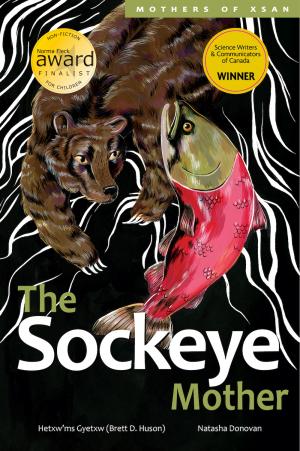
The Sockeye Mother
The Sockeye Mother tells the story of the sockeye salmon through the seasons and how, during its lifecycle, it nourishes the land that the Skeena River flows through. The Gitxsan people, Indigenous peoples who live along the Skeena River in the northwest interior of British Columbia, make this land their home. It is because of the sockeye salmon that the forests, landscapes and people can exist here.
Throughout the book, there are bright illustrations that move across the page. They create a feeling of constant motion while the salmon are making their journey. The bright orange, red and green of the salmon stand out against the black of the moving river as well as the greens of the weeds or foliage along the water. The strong illustration of the grizzly also repeats a couple of times as do some images of Gitxsan art.
This book would be a perfect read aloud for the junior grades. It connects to the Grade four Social Studies curriculum by giving a beautifully illustrated story of the relationship between a society and the environment, an overall expectation in the Heritage and Identity strand of the curriculum. When I read, “The young sockeye has so far avoided predators, escaping the hungry hands of ‘watxs – the otter – and dodging the unnaturally changing landscape, denuded by the clear-cutting of man,” I thought of how this connects to the overall expectation in the Grade five social studies curriculum strand about people and the environment. Students in Grade five use the inquiry process to investigate issues associated with balancing human needs and activities with environmental stewardship. This definitely introduces the issue.
Not only could this book be used as part of the Social Studies curriculum but it is an exciting story to portray the interdependence of plants and animals within a specific habitat, an expectation in the Grade four science strand about habitats and communities. It can also be used while teaching biodiversity which is a Grade six science strand.
I highly recommend this book. I love not only the incredible illustrations and beautiful story but also how much it can be used to engage students in learning.
Jane Ranson is a member of the Limestone Teacher Local.